Fashion Industry: Ethical Theory and Corporate Social Responsibility
VerifiedAdded on 2022/10/09
|11
|3467
|19
Essay
AI Summary
This essay delves into the ethical complexities of the fashion industry, examining critical issues such as child labor, health and safety risks, environmental degradation, and animal cruelty. It explores the industry's relationship with Corporate Social Responsibility (CSR), highlighting both negative aspects, like poor labor practices, and positive examples of companies like Zara that prioritize sustainability. The essay discusses ethical theories, particularly utilitarianism, and how they apply to the fashion industry's CSR efforts. It emphasizes the importance of ethical behavior, including respecting social and ethical norms, and the increasing consumer pressure on fashion brands to improve their impact on the environment and society. The analysis covers Zara's commitment to reducing its carbon footprint through eco-friendly store designs and sustainable practices.
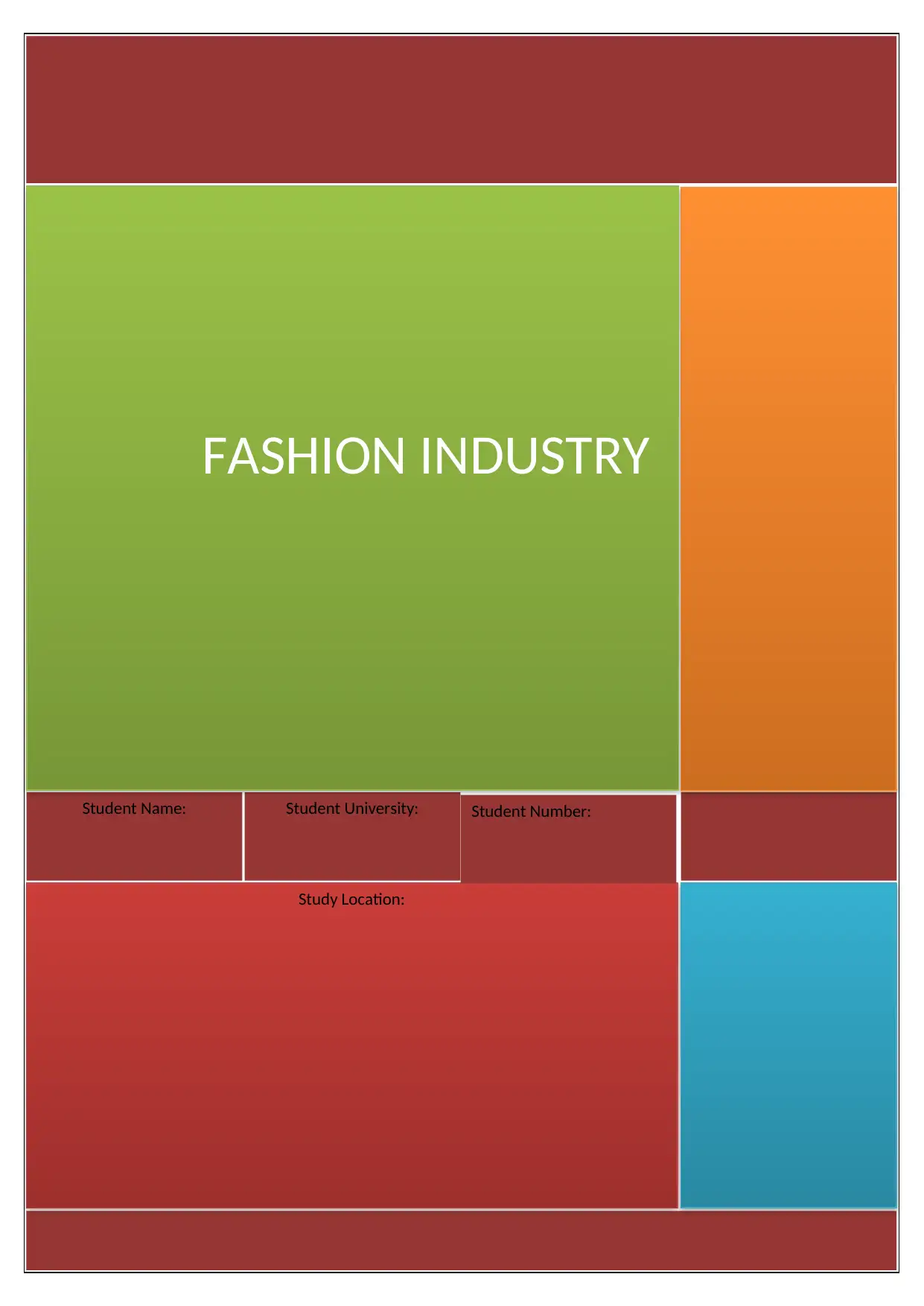
Running Head: FASHION 0
Study Location:
Student Number:Student University:Student Name:
FASHION INDUSTRY
Study Location:
Student Number:Student University:Student Name:
FASHION INDUSTRY
Paraphrase This Document
Need a fresh take? Get an instant paraphrase of this document with our AI Paraphraser
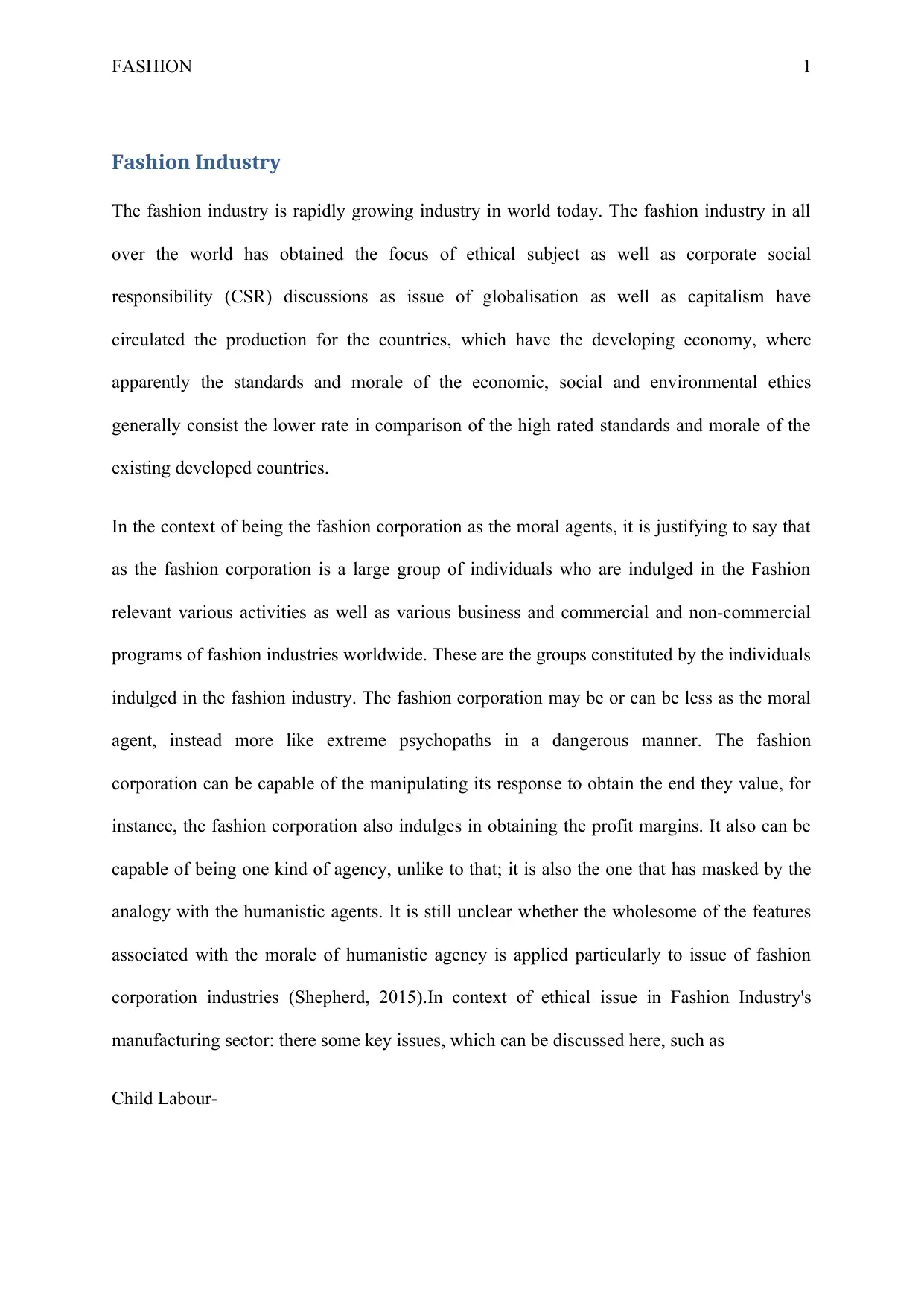
FASHION 1
Fashion Industry
The fashion industry is rapidly growing industry in world today. The fashion industry in all
over the world has obtained the focus of ethical subject as well as corporate social
responsibility (CSR) discussions as issue of globalisation as well as capitalism have
circulated the production for the countries, which have the developing economy, where
apparently the standards and morale of the economic, social and environmental ethics
generally consist the lower rate in comparison of the high rated standards and morale of the
existing developed countries.
In the context of being the fashion corporation as the moral agents, it is justifying to say that
as the fashion corporation is a large group of individuals who are indulged in the Fashion
relevant various activities as well as various business and commercial and non-commercial
programs of fashion industries worldwide. These are the groups constituted by the individuals
indulged in the fashion industry. The fashion corporation may be or can be less as the moral
agent, instead more like extreme psychopaths in a dangerous manner. The fashion
corporation can be capable of the manipulating its response to obtain the end they value, for
instance, the fashion corporation also indulges in obtaining the profit margins. It also can be
capable of being one kind of agency, unlike to that; it is also the one that has masked by the
analogy with the humanistic agents. It is still unclear whether the wholesome of the features
associated with the morale of humanistic agency is applied particularly to issue of fashion
corporation industries (Shepherd, 2015).In context of ethical issue in Fashion Industry's
manufacturing sector: there some key issues, which can be discussed here, such as
Child Labour-
Fashion Industry
The fashion industry is rapidly growing industry in world today. The fashion industry in all
over the world has obtained the focus of ethical subject as well as corporate social
responsibility (CSR) discussions as issue of globalisation as well as capitalism have
circulated the production for the countries, which have the developing economy, where
apparently the standards and morale of the economic, social and environmental ethics
generally consist the lower rate in comparison of the high rated standards and morale of the
existing developed countries.
In the context of being the fashion corporation as the moral agents, it is justifying to say that
as the fashion corporation is a large group of individuals who are indulged in the Fashion
relevant various activities as well as various business and commercial and non-commercial
programs of fashion industries worldwide. These are the groups constituted by the individuals
indulged in the fashion industry. The fashion corporation may be or can be less as the moral
agent, instead more like extreme psychopaths in a dangerous manner. The fashion
corporation can be capable of the manipulating its response to obtain the end they value, for
instance, the fashion corporation also indulges in obtaining the profit margins. It also can be
capable of being one kind of agency, unlike to that; it is also the one that has masked by the
analogy with the humanistic agents. It is still unclear whether the wholesome of the features
associated with the morale of humanistic agency is applied particularly to issue of fashion
corporation industries (Shepherd, 2015).In context of ethical issue in Fashion Industry's
manufacturing sector: there some key issues, which can be discussed here, such as
Child Labour-
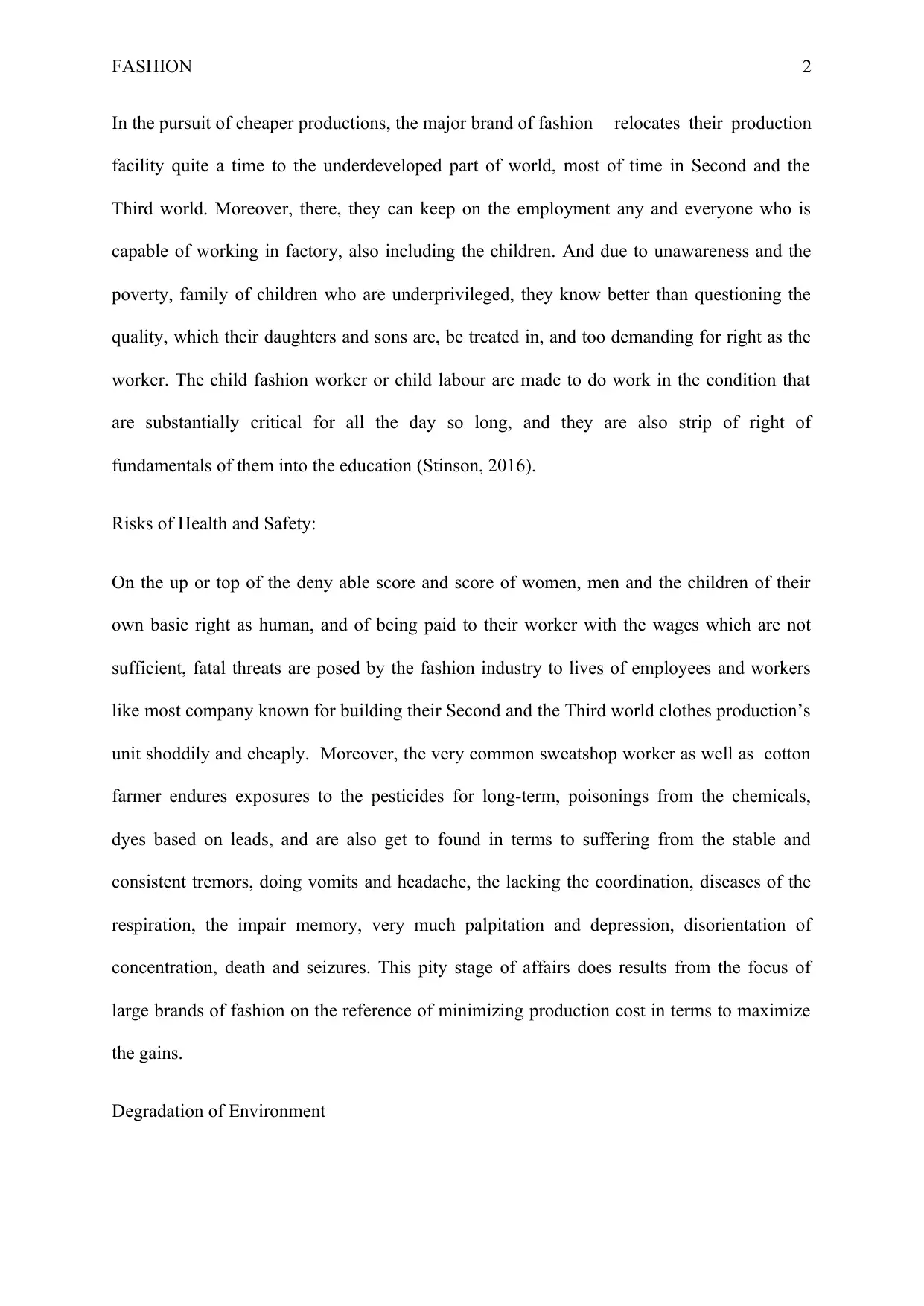
FASHION 2
In the pursuit of cheaper productions, the major brand of fashion relocates their production
facility quite a time to the underdeveloped part of world, most of time in Second and the
Third world. Moreover, there, they can keep on the employment any and everyone who is
capable of working in factory, also including the children. And due to unawareness and the
poverty, family of children who are underprivileged, they know better than questioning the
quality, which their daughters and sons are, be treated in, and too demanding for right as the
worker. The child fashion worker or child labour are made to do work in the condition that
are substantially critical for all the day so long, and they are also strip of right of
fundamentals of them into the education (Stinson, 2016).
Risks of Health and Safety:
On the up or top of the deny able score and score of women, men and the children of their
own basic right as human, and of being paid to their worker with the wages which are not
sufficient, fatal threats are posed by the fashion industry to lives of employees and workers
like most company known for building their Second and the Third world clothes production’s
unit shoddily and cheaply. Moreover, the very common sweatshop worker as well as cotton
farmer endures exposures to the pesticides for long-term, poisonings from the chemicals,
dyes based on leads, and are also get to found in terms to suffering from the stable and
consistent tremors, doing vomits and headache, the lacking the coordination, diseases of the
respiration, the impair memory, very much palpitation and depression, disorientation of
concentration, death and seizures. This pity stage of affairs does results from the focus of
large brands of fashion on the reference of minimizing production cost in terms to maximize
the gains.
Degradation of Environment
In the pursuit of cheaper productions, the major brand of fashion relocates their production
facility quite a time to the underdeveloped part of world, most of time in Second and the
Third world. Moreover, there, they can keep on the employment any and everyone who is
capable of working in factory, also including the children. And due to unawareness and the
poverty, family of children who are underprivileged, they know better than questioning the
quality, which their daughters and sons are, be treated in, and too demanding for right as the
worker. The child fashion worker or child labour are made to do work in the condition that
are substantially critical for all the day so long, and they are also strip of right of
fundamentals of them into the education (Stinson, 2016).
Risks of Health and Safety:
On the up or top of the deny able score and score of women, men and the children of their
own basic right as human, and of being paid to their worker with the wages which are not
sufficient, fatal threats are posed by the fashion industry to lives of employees and workers
like most company known for building their Second and the Third world clothes production’s
unit shoddily and cheaply. Moreover, the very common sweatshop worker as well as cotton
farmer endures exposures to the pesticides for long-term, poisonings from the chemicals,
dyes based on leads, and are also get to found in terms to suffering from the stable and
consistent tremors, doing vomits and headache, the lacking the coordination, diseases of the
respiration, the impair memory, very much palpitation and depression, disorientation of
concentration, death and seizures. This pity stage of affairs does results from the focus of
large brands of fashion on the reference of minimizing production cost in terms to maximize
the gains.
Degradation of Environment
⊘ This is a preview!⊘
Do you want full access?
Subscribe today to unlock all pages.

Trusted by 1+ million students worldwide
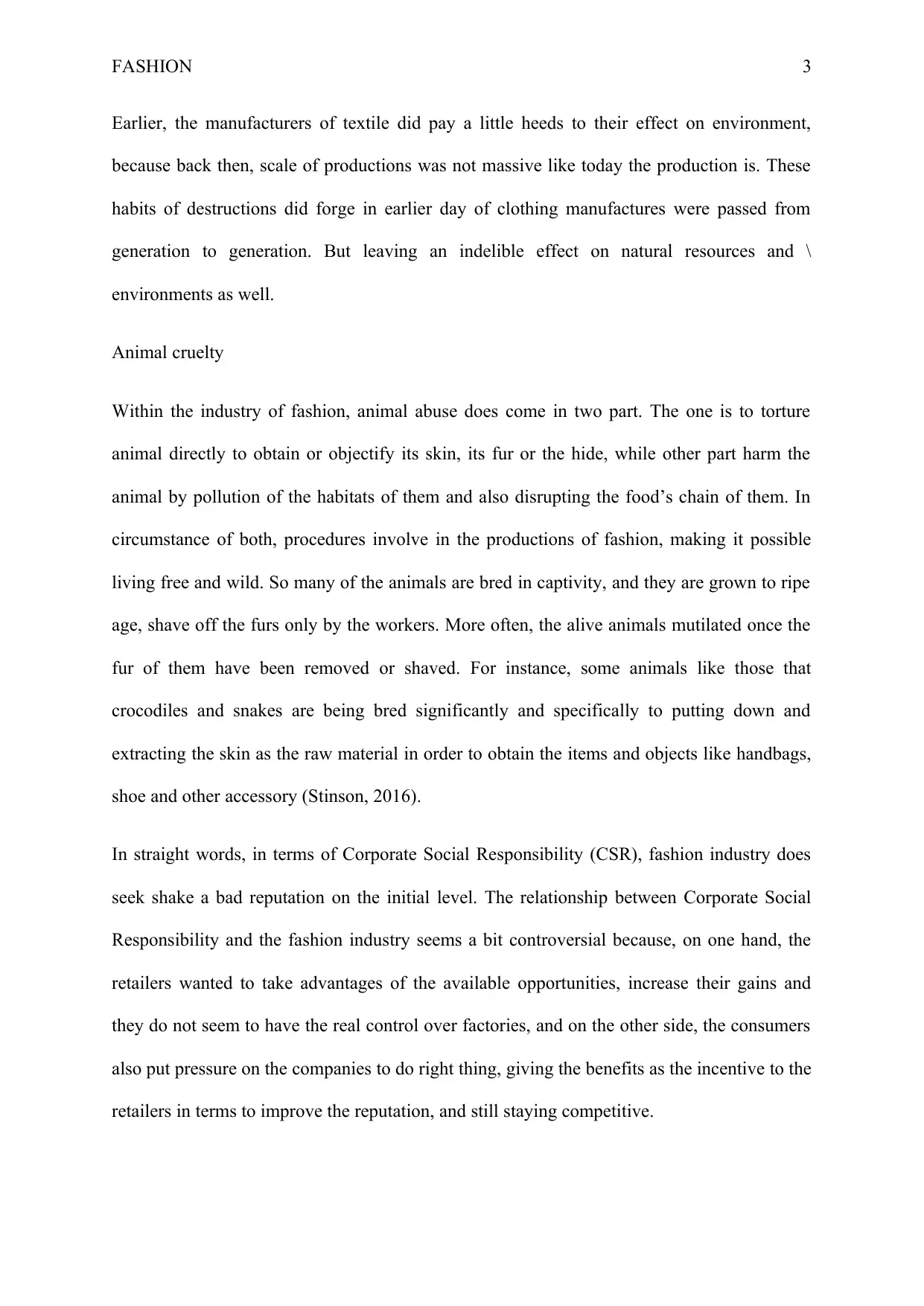
FASHION 3
Earlier, the manufacturers of textile did pay a little heeds to their effect on environment,
because back then, scale of productions was not massive like today the production is. These
habits of destructions did forge in earlier day of clothing manufactures were passed from
generation to generation. But leaving an indelible effect on natural resources and \
environments as well.
Animal cruelty
Within the industry of fashion, animal abuse does come in two part. The one is to torture
animal directly to obtain or objectify its skin, its fur or the hide, while other part harm the
animal by pollution of the habitats of them and also disrupting the food’s chain of them. In
circumstance of both, procedures involve in the productions of fashion, making it possible
living free and wild. So many of the animals are bred in captivity, and they are grown to ripe
age, shave off the furs only by the workers. More often, the alive animals mutilated once the
fur of them have been removed or shaved. For instance, some animals like those that
crocodiles and snakes are being bred significantly and specifically to putting down and
extracting the skin as the raw material in order to obtain the items and objects like handbags,
shoe and other accessory (Stinson, 2016).
In straight words, in terms of Corporate Social Responsibility (CSR), fashion industry does
seek shake a bad reputation on the initial level. The relationship between Corporate Social
Responsibility and the fashion industry seems a bit controversial because, on one hand, the
retailers wanted to take advantages of the available opportunities, increase their gains and
they do not seem to have the real control over factories, and on the other side, the consumers
also put pressure on the companies to do right thing, giving the benefits as the incentive to the
retailers in terms to improve the reputation, and still staying competitive.
Earlier, the manufacturers of textile did pay a little heeds to their effect on environment,
because back then, scale of productions was not massive like today the production is. These
habits of destructions did forge in earlier day of clothing manufactures were passed from
generation to generation. But leaving an indelible effect on natural resources and \
environments as well.
Animal cruelty
Within the industry of fashion, animal abuse does come in two part. The one is to torture
animal directly to obtain or objectify its skin, its fur or the hide, while other part harm the
animal by pollution of the habitats of them and also disrupting the food’s chain of them. In
circumstance of both, procedures involve in the productions of fashion, making it possible
living free and wild. So many of the animals are bred in captivity, and they are grown to ripe
age, shave off the furs only by the workers. More often, the alive animals mutilated once the
fur of them have been removed or shaved. For instance, some animals like those that
crocodiles and snakes are being bred significantly and specifically to putting down and
extracting the skin as the raw material in order to obtain the items and objects like handbags,
shoe and other accessory (Stinson, 2016).
In straight words, in terms of Corporate Social Responsibility (CSR), fashion industry does
seek shake a bad reputation on the initial level. The relationship between Corporate Social
Responsibility and the fashion industry seems a bit controversial because, on one hand, the
retailers wanted to take advantages of the available opportunities, increase their gains and
they do not seem to have the real control over factories, and on the other side, the consumers
also put pressure on the companies to do right thing, giving the benefits as the incentive to the
retailers in terms to improve the reputation, and still staying competitive.
Paraphrase This Document
Need a fresh take? Get an instant paraphrase of this document with our AI Paraphraser
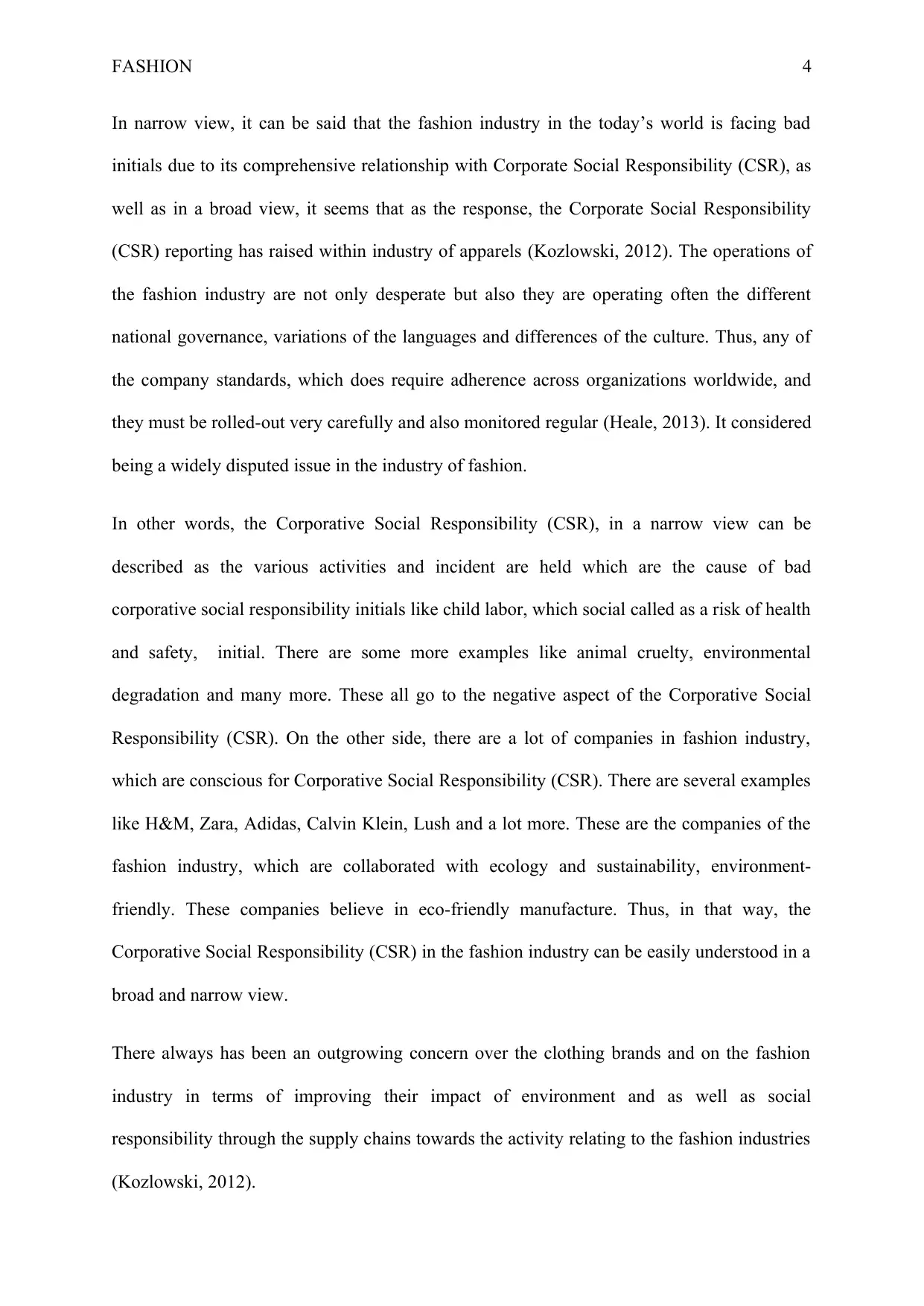
FASHION 4
In narrow view, it can be said that the fashion industry in the today’s world is facing bad
initials due to its comprehensive relationship with Corporate Social Responsibility (CSR), as
well as in a broad view, it seems that as the response, the Corporate Social Responsibility
(CSR) reporting has raised within industry of apparels (Kozlowski, 2012). The operations of
the fashion industry are not only desperate but also they are operating often the different
national governance, variations of the languages and differences of the culture. Thus, any of
the company standards, which does require adherence across organizations worldwide, and
they must be rolled-out very carefully and also monitored regular (Heale, 2013). It considered
being a widely disputed issue in the industry of fashion.
In other words, the Corporative Social Responsibility (CSR), in a narrow view can be
described as the various activities and incident are held which are the cause of bad
corporative social responsibility initials like child labor, which social called as a risk of health
and safety, initial. There are some more examples like animal cruelty, environmental
degradation and many more. These all go to the negative aspect of the Corporative Social
Responsibility (CSR). On the other side, there are a lot of companies in fashion industry,
which are conscious for Corporative Social Responsibility (CSR). There are several examples
like H&M, Zara, Adidas, Calvin Klein, Lush and a lot more. These are the companies of the
fashion industry, which are collaborated with ecology and sustainability, environment-
friendly. These companies believe in eco-friendly manufacture. Thus, in that way, the
Corporative Social Responsibility (CSR) in the fashion industry can be easily understood in a
broad and narrow view.
There always has been an outgrowing concern over the clothing brands and on the fashion
industry in terms of improving their impact of environment and as well as social
responsibility through the supply chains towards the activity relating to the fashion industries
(Kozlowski, 2012).
In narrow view, it can be said that the fashion industry in the today’s world is facing bad
initials due to its comprehensive relationship with Corporate Social Responsibility (CSR), as
well as in a broad view, it seems that as the response, the Corporate Social Responsibility
(CSR) reporting has raised within industry of apparels (Kozlowski, 2012). The operations of
the fashion industry are not only desperate but also they are operating often the different
national governance, variations of the languages and differences of the culture. Thus, any of
the company standards, which does require adherence across organizations worldwide, and
they must be rolled-out very carefully and also monitored regular (Heale, 2013). It considered
being a widely disputed issue in the industry of fashion.
In other words, the Corporative Social Responsibility (CSR), in a narrow view can be
described as the various activities and incident are held which are the cause of bad
corporative social responsibility initials like child labor, which social called as a risk of health
and safety, initial. There are some more examples like animal cruelty, environmental
degradation and many more. These all go to the negative aspect of the Corporative Social
Responsibility (CSR). On the other side, there are a lot of companies in fashion industry,
which are conscious for Corporative Social Responsibility (CSR). There are several examples
like H&M, Zara, Adidas, Calvin Klein, Lush and a lot more. These are the companies of the
fashion industry, which are collaborated with ecology and sustainability, environment-
friendly. These companies believe in eco-friendly manufacture. Thus, in that way, the
Corporative Social Responsibility (CSR) in the fashion industry can be easily understood in a
broad and narrow view.
There always has been an outgrowing concern over the clothing brands and on the fashion
industry in terms of improving their impact of environment and as well as social
responsibility through the supply chains towards the activity relating to the fashion industries
(Kozlowski, 2012).
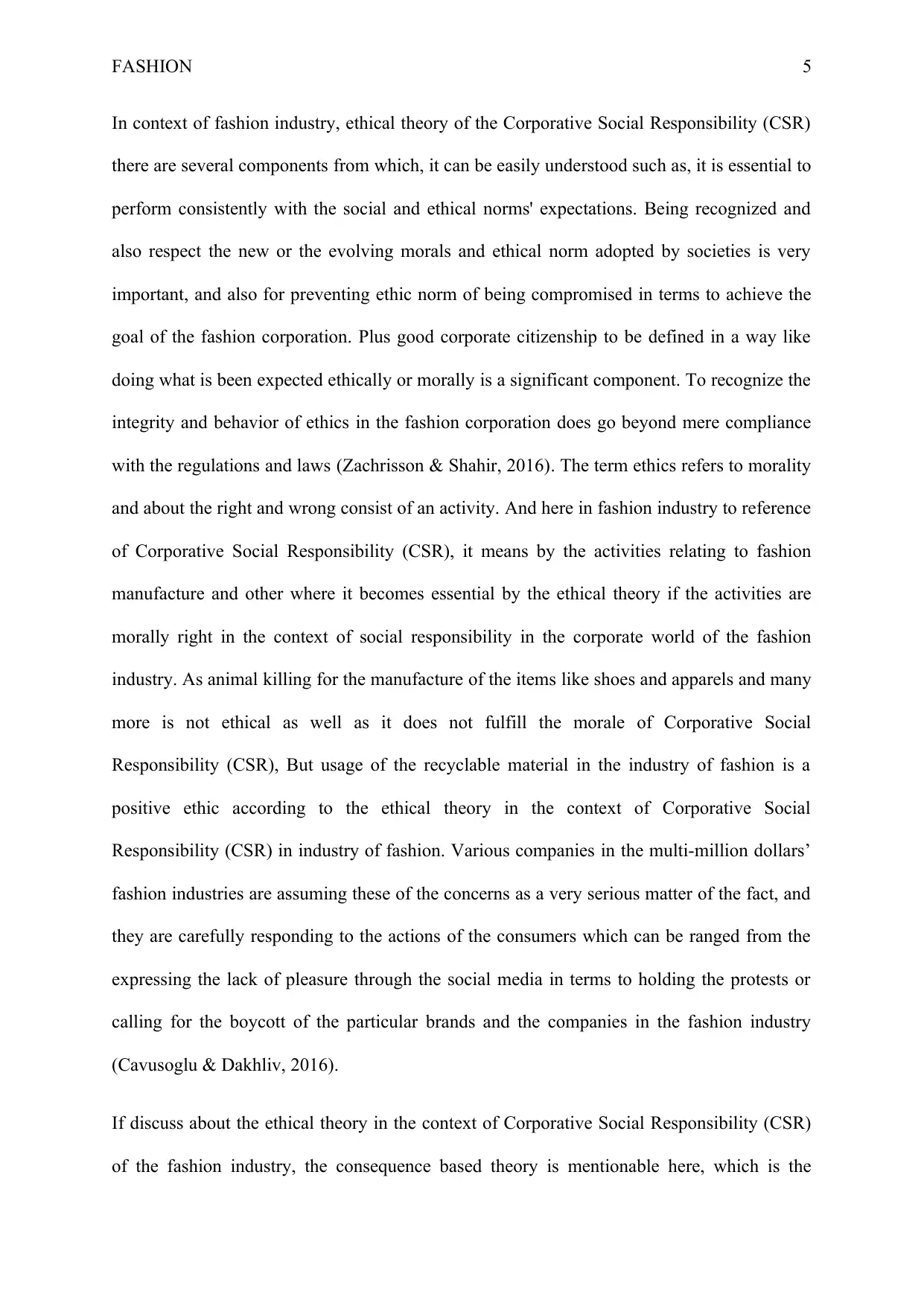
FASHION 5
In context of fashion industry, ethical theory of the Corporative Social Responsibility (CSR)
there are several components from which, it can be easily understood such as, it is essential to
perform consistently with the social and ethical norms' expectations. Being recognized and
also respect the new or the evolving morals and ethical norm adopted by societies is very
important, and also for preventing ethic norm of being compromised in terms to achieve the
goal of the fashion corporation. Plus good corporate citizenship to be defined in a way like
doing what is been expected ethically or morally is a significant component. To recognize the
integrity and behavior of ethics in the fashion corporation does go beyond mere compliance
with the regulations and laws (Zachrisson & Shahir, 2016). The term ethics refers to morality
and about the right and wrong consist of an activity. And here in fashion industry to reference
of Corporative Social Responsibility (CSR), it means by the activities relating to fashion
manufacture and other where it becomes essential by the ethical theory if the activities are
morally right in the context of social responsibility in the corporate world of the fashion
industry. As animal killing for the manufacture of the items like shoes and apparels and many
more is not ethical as well as it does not fulfill the morale of Corporative Social
Responsibility (CSR), But usage of the recyclable material in the industry of fashion is a
positive ethic according to the ethical theory in the context of Corporative Social
Responsibility (CSR) in industry of fashion. Various companies in the multi-million dollars’
fashion industries are assuming these of the concerns as a very serious matter of the fact, and
they are carefully responding to the actions of the consumers which can be ranged from the
expressing the lack of pleasure through the social media in terms to holding the protests or
calling for the boycott of the particular brands and the companies in the fashion industry
(Cavusoglu & Dakhliv, 2016).
If discuss about the ethical theory in the context of Corporative Social Responsibility (CSR)
of the fashion industry, the consequence based theory is mentionable here, which is the
In context of fashion industry, ethical theory of the Corporative Social Responsibility (CSR)
there are several components from which, it can be easily understood such as, it is essential to
perform consistently with the social and ethical norms' expectations. Being recognized and
also respect the new or the evolving morals and ethical norm adopted by societies is very
important, and also for preventing ethic norm of being compromised in terms to achieve the
goal of the fashion corporation. Plus good corporate citizenship to be defined in a way like
doing what is been expected ethically or morally is a significant component. To recognize the
integrity and behavior of ethics in the fashion corporation does go beyond mere compliance
with the regulations and laws (Zachrisson & Shahir, 2016). The term ethics refers to morality
and about the right and wrong consist of an activity. And here in fashion industry to reference
of Corporative Social Responsibility (CSR), it means by the activities relating to fashion
manufacture and other where it becomes essential by the ethical theory if the activities are
morally right in the context of social responsibility in the corporate world of the fashion
industry. As animal killing for the manufacture of the items like shoes and apparels and many
more is not ethical as well as it does not fulfill the morale of Corporative Social
Responsibility (CSR), But usage of the recyclable material in the industry of fashion is a
positive ethic according to the ethical theory in the context of Corporative Social
Responsibility (CSR) in industry of fashion. Various companies in the multi-million dollars’
fashion industries are assuming these of the concerns as a very serious matter of the fact, and
they are carefully responding to the actions of the consumers which can be ranged from the
expressing the lack of pleasure through the social media in terms to holding the protests or
calling for the boycott of the particular brands and the companies in the fashion industry
(Cavusoglu & Dakhliv, 2016).
If discuss about the ethical theory in the context of Corporative Social Responsibility (CSR)
of the fashion industry, the consequence based theory is mentionable here, which is the
⊘ This is a preview!⊘
Do you want full access?
Subscribe today to unlock all pages.

Trusted by 1+ million students worldwide
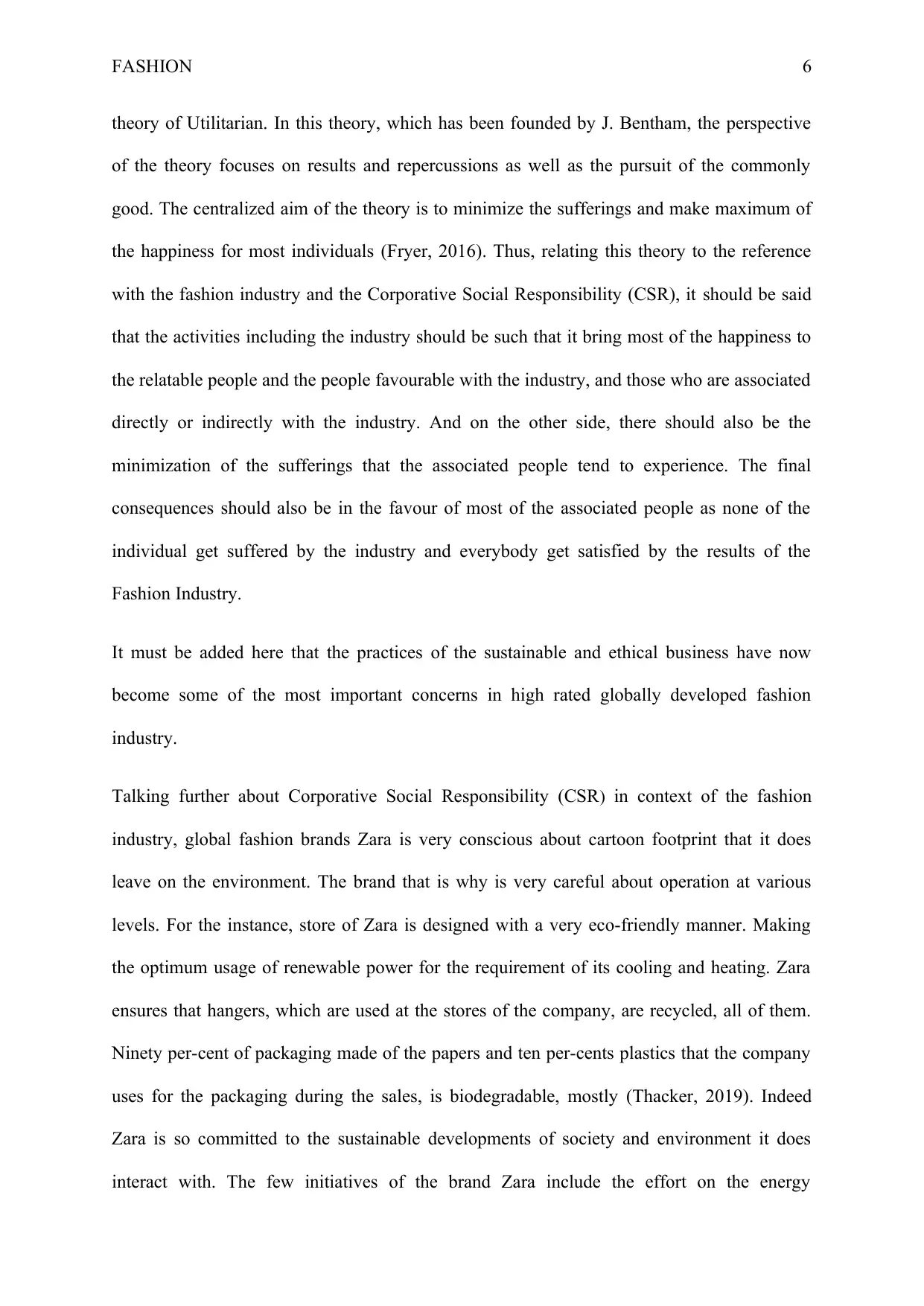
FASHION 6
theory of Utilitarian. In this theory, which has been founded by J. Bentham, the perspective
of the theory focuses on results and repercussions as well as the pursuit of the commonly
good. The centralized aim of the theory is to minimize the sufferings and make maximum of
the happiness for most individuals (Fryer, 2016). Thus, relating this theory to the reference
with the fashion industry and the Corporative Social Responsibility (CSR), it should be said
that the activities including the industry should be such that it bring most of the happiness to
the relatable people and the people favourable with the industry, and those who are associated
directly or indirectly with the industry. And on the other side, there should also be the
minimization of the sufferings that the associated people tend to experience. The final
consequences should also be in the favour of most of the associated people as none of the
individual get suffered by the industry and everybody get satisfied by the results of the
Fashion Industry.
It must be added here that the practices of the sustainable and ethical business have now
become some of the most important concerns in high rated globally developed fashion
industry.
Talking further about Corporative Social Responsibility (CSR) in context of the fashion
industry, global fashion brands Zara is very conscious about cartoon footprint that it does
leave on the environment. The brand that is why is very careful about operation at various
levels. For the instance, store of Zara is designed with a very eco-friendly manner. Making
the optimum usage of renewable power for the requirement of its cooling and heating. Zara
ensures that hangers, which are used at the stores of the company, are recycled, all of them.
Ninety per-cent of packaging made of the papers and ten per-cents plastics that the company
uses for the packaging during the sales, is biodegradable, mostly (Thacker, 2019). Indeed
Zara is so committed to the sustainable developments of society and environment it does
interact with. The few initiatives of the brand Zara include the effort on the energy
theory of Utilitarian. In this theory, which has been founded by J. Bentham, the perspective
of the theory focuses on results and repercussions as well as the pursuit of the commonly
good. The centralized aim of the theory is to minimize the sufferings and make maximum of
the happiness for most individuals (Fryer, 2016). Thus, relating this theory to the reference
with the fashion industry and the Corporative Social Responsibility (CSR), it should be said
that the activities including the industry should be such that it bring most of the happiness to
the relatable people and the people favourable with the industry, and those who are associated
directly or indirectly with the industry. And on the other side, there should also be the
minimization of the sufferings that the associated people tend to experience. The final
consequences should also be in the favour of most of the associated people as none of the
individual get suffered by the industry and everybody get satisfied by the results of the
Fashion Industry.
It must be added here that the practices of the sustainable and ethical business have now
become some of the most important concerns in high rated globally developed fashion
industry.
Talking further about Corporative Social Responsibility (CSR) in context of the fashion
industry, global fashion brands Zara is very conscious about cartoon footprint that it does
leave on the environment. The brand that is why is very careful about operation at various
levels. For the instance, store of Zara is designed with a very eco-friendly manner. Making
the optimum usage of renewable power for the requirement of its cooling and heating. Zara
ensures that hangers, which are used at the stores of the company, are recycled, all of them.
Ninety per-cent of packaging made of the papers and ten per-cents plastics that the company
uses for the packaging during the sales, is biodegradable, mostly (Thacker, 2019). Indeed
Zara is so committed to the sustainable developments of society and environment it does
interact with. The few initiatives of the brand Zara include the effort on the energy
Paraphrase This Document
Need a fresh take? Get an instant paraphrase of this document with our AI Paraphraser
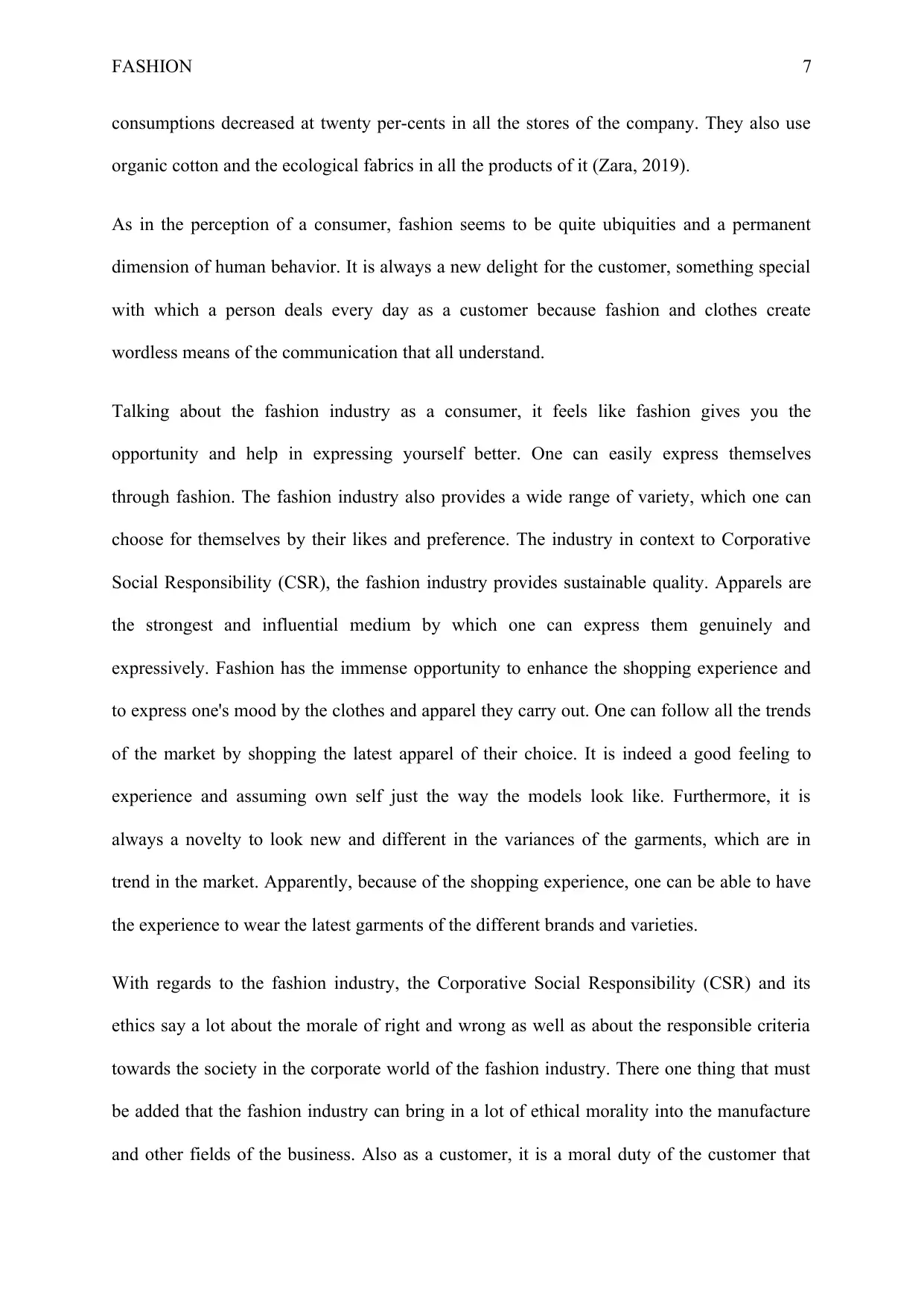
FASHION 7
consumptions decreased at twenty per-cents in all the stores of the company. They also use
organic cotton and the ecological fabrics in all the products of it (Zara, 2019).
As in the perception of a consumer, fashion seems to be quite ubiquities and a permanent
dimension of human behavior. It is always a new delight for the customer, something special
with which a person deals every day as a customer because fashion and clothes create
wordless means of the communication that all understand.
Talking about the fashion industry as a consumer, it feels like fashion gives you the
opportunity and help in expressing yourself better. One can easily express themselves
through fashion. The fashion industry also provides a wide range of variety, which one can
choose for themselves by their likes and preference. The industry in context to Corporative
Social Responsibility (CSR), the fashion industry provides sustainable quality. Apparels are
the strongest and influential medium by which one can express them genuinely and
expressively. Fashion has the immense opportunity to enhance the shopping experience and
to express one's mood by the clothes and apparel they carry out. One can follow all the trends
of the market by shopping the latest apparel of their choice. It is indeed a good feeling to
experience and assuming own self just the way the models look like. Furthermore, it is
always a novelty to look new and different in the variances of the garments, which are in
trend in the market. Apparently, because of the shopping experience, one can be able to have
the experience to wear the latest garments of the different brands and varieties.
With regards to the fashion industry, the Corporative Social Responsibility (CSR) and its
ethics say a lot about the morale of right and wrong as well as about the responsible criteria
towards the society in the corporate world of the fashion industry. There one thing that must
be added that the fashion industry can bring in a lot of ethical morality into the manufacture
and other fields of the business. Also as a customer, it is a moral duty of the customer that
consumptions decreased at twenty per-cents in all the stores of the company. They also use
organic cotton and the ecological fabrics in all the products of it (Zara, 2019).
As in the perception of a consumer, fashion seems to be quite ubiquities and a permanent
dimension of human behavior. It is always a new delight for the customer, something special
with which a person deals every day as a customer because fashion and clothes create
wordless means of the communication that all understand.
Talking about the fashion industry as a consumer, it feels like fashion gives you the
opportunity and help in expressing yourself better. One can easily express themselves
through fashion. The fashion industry also provides a wide range of variety, which one can
choose for themselves by their likes and preference. The industry in context to Corporative
Social Responsibility (CSR), the fashion industry provides sustainable quality. Apparels are
the strongest and influential medium by which one can express them genuinely and
expressively. Fashion has the immense opportunity to enhance the shopping experience and
to express one's mood by the clothes and apparel they carry out. One can follow all the trends
of the market by shopping the latest apparel of their choice. It is indeed a good feeling to
experience and assuming own self just the way the models look like. Furthermore, it is
always a novelty to look new and different in the variances of the garments, which are in
trend in the market. Apparently, because of the shopping experience, one can be able to have
the experience to wear the latest garments of the different brands and varieties.
With regards to the fashion industry, the Corporative Social Responsibility (CSR) and its
ethics say a lot about the morale of right and wrong as well as about the responsible criteria
towards the society in the corporate world of the fashion industry. There one thing that must
be added that the fashion industry can bring in a lot of ethical morality into the manufacture
and other fields of the business. Also as a customer, it is a moral duty of the customer that
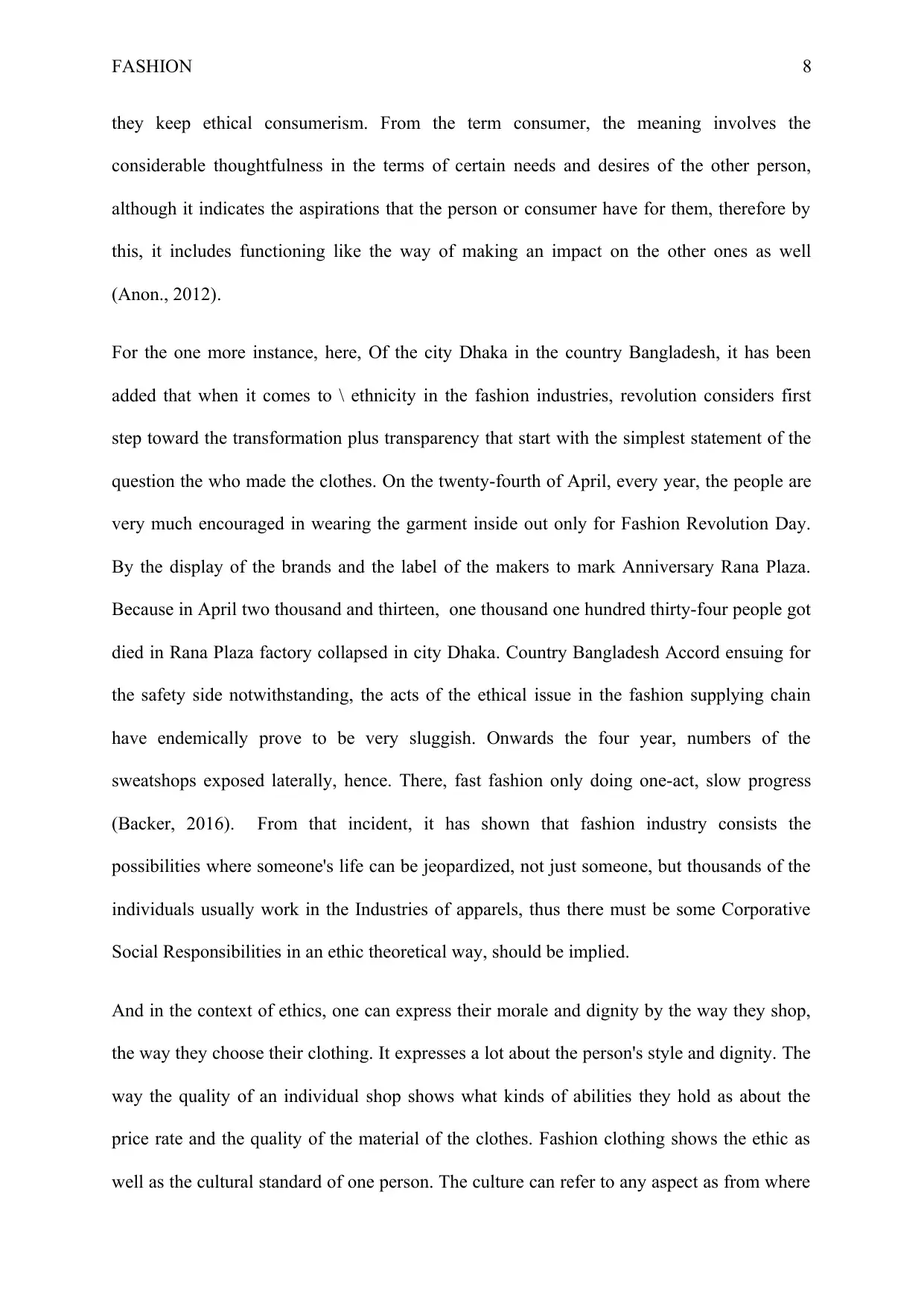
FASHION 8
they keep ethical consumerism. From the term consumer, the meaning involves the
considerable thoughtfulness in the terms of certain needs and desires of the other person,
although it indicates the aspirations that the person or consumer have for them, therefore by
this, it includes functioning like the way of making an impact on the other ones as well
(Anon., 2012).
For the one more instance, here, Of the city Dhaka in the country Bangladesh, it has been
added that when it comes to \ ethnicity in the fashion industries, revolution considers first
step toward the transformation plus transparency that start with the simplest statement of the
question the who made the clothes. On the twenty-fourth of April, every year, the people are
very much encouraged in wearing the garment inside out only for Fashion Revolution Day.
By the display of the brands and the label of the makers to mark Anniversary Rana Plaza.
Because in April two thousand and thirteen, one thousand one hundred thirty-four people got
died in Rana Plaza factory collapsed in city Dhaka. Country Bangladesh Accord ensuing for
the safety side notwithstanding, the acts of the ethical issue in the fashion supplying chain
have endemically prove to be very sluggish. Onwards the four year, numbers of the
sweatshops exposed laterally, hence. There, fast fashion only doing one-act, slow progress
(Backer, 2016). From that incident, it has shown that fashion industry consists the
possibilities where someone's life can be jeopardized, not just someone, but thousands of the
individuals usually work in the Industries of apparels, thus there must be some Corporative
Social Responsibilities in an ethic theoretical way, should be implied.
And in the context of ethics, one can express their morale and dignity by the way they shop,
the way they choose their clothing. It expresses a lot about the person's style and dignity. The
way the quality of an individual shop shows what kinds of abilities they hold as about the
price rate and the quality of the material of the clothes. Fashion clothing shows the ethic as
well as the cultural standard of one person. The culture can refer to any aspect as from where
they keep ethical consumerism. From the term consumer, the meaning involves the
considerable thoughtfulness in the terms of certain needs and desires of the other person,
although it indicates the aspirations that the person or consumer have for them, therefore by
this, it includes functioning like the way of making an impact on the other ones as well
(Anon., 2012).
For the one more instance, here, Of the city Dhaka in the country Bangladesh, it has been
added that when it comes to \ ethnicity in the fashion industries, revolution considers first
step toward the transformation plus transparency that start with the simplest statement of the
question the who made the clothes. On the twenty-fourth of April, every year, the people are
very much encouraged in wearing the garment inside out only for Fashion Revolution Day.
By the display of the brands and the label of the makers to mark Anniversary Rana Plaza.
Because in April two thousand and thirteen, one thousand one hundred thirty-four people got
died in Rana Plaza factory collapsed in city Dhaka. Country Bangladesh Accord ensuing for
the safety side notwithstanding, the acts of the ethical issue in the fashion supplying chain
have endemically prove to be very sluggish. Onwards the four year, numbers of the
sweatshops exposed laterally, hence. There, fast fashion only doing one-act, slow progress
(Backer, 2016). From that incident, it has shown that fashion industry consists the
possibilities where someone's life can be jeopardized, not just someone, but thousands of the
individuals usually work in the Industries of apparels, thus there must be some Corporative
Social Responsibilities in an ethic theoretical way, should be implied.
And in the context of ethics, one can express their morale and dignity by the way they shop,
the way they choose their clothing. It expresses a lot about the person's style and dignity. The
way the quality of an individual shop shows what kinds of abilities they hold as about the
price rate and the quality of the material of the clothes. Fashion clothing shows the ethic as
well as the cultural standard of one person. The culture can refer to any aspect as from where
⊘ This is a preview!⊘
Do you want full access?
Subscribe today to unlock all pages.

Trusted by 1+ million students worldwide
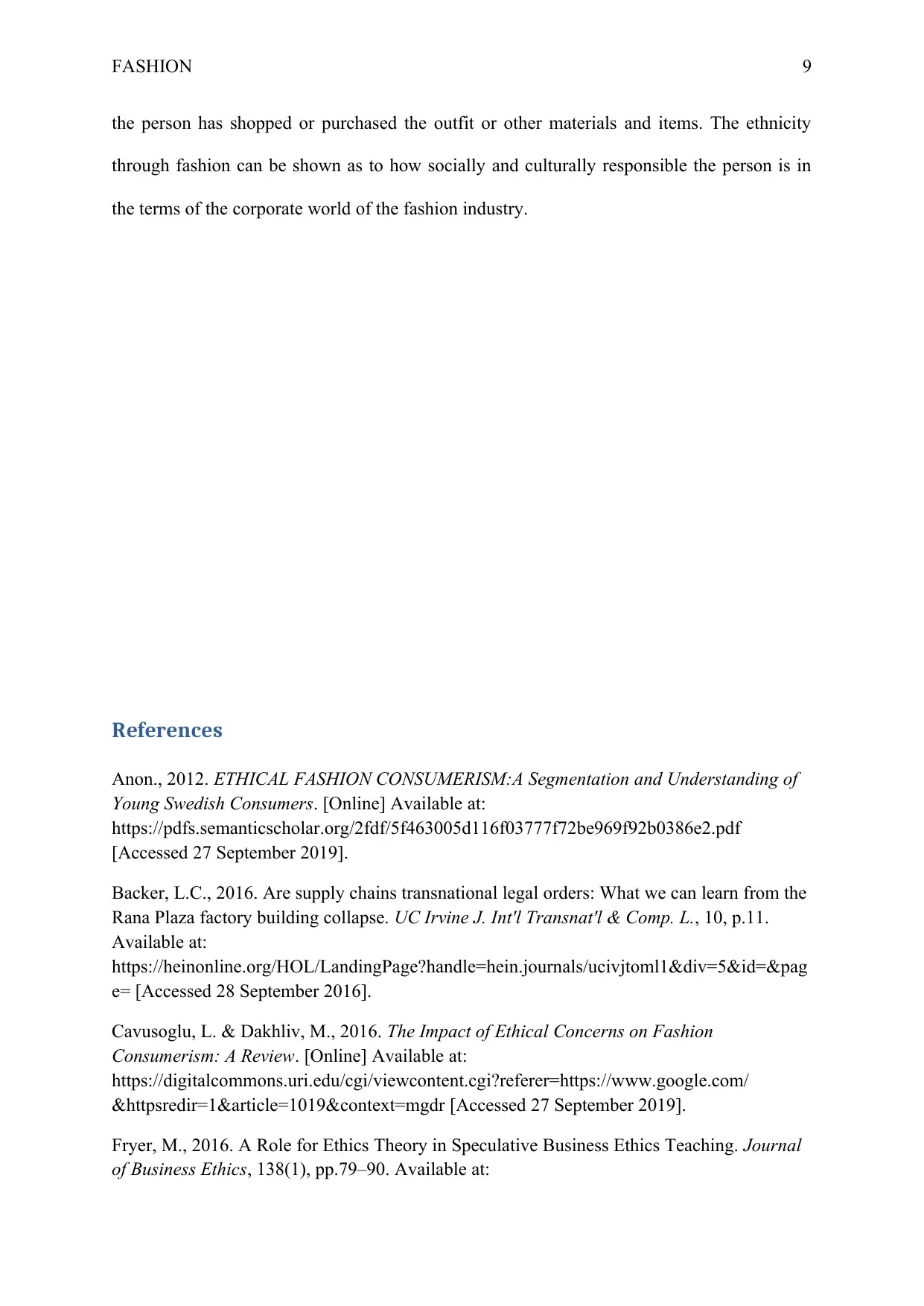
FASHION 9
the person has shopped or purchased the outfit or other materials and items. The ethnicity
through fashion can be shown as to how socially and culturally responsible the person is in
the terms of the corporate world of the fashion industry.
References
Anon., 2012. ETHICAL FASHION CONSUMERISM:A Segmentation and Understanding of
Young Swedish Consumers. [Online] Available at:
https://pdfs.semanticscholar.org/2fdf/5f463005d116f03777f72be969f92b0386e2.pdf
[Accessed 27 September 2019].
Backer, L.C., 2016. Are supply chains transnational legal orders: What we can learn from the
Rana Plaza factory building collapse. UC Irvine J. Int'l Transnat'l & Comp. L., 10, p.11.
Available at:
https://heinonline.org/HOL/LandingPage?handle=hein.journals/ucivjtoml1&div=5&id=&pag
e= [Accessed 28 September 2016].
Cavusoglu, L. & Dakhliv, M., 2016. The Impact of Ethical Concerns on Fashion
Consumerism: A Review. [Online] Available at:
https://digitalcommons.uri.edu/cgi/viewcontent.cgi?referer=https://www.google.com/
&httpsredir=1&article=1019&context=mgdr [Accessed 27 September 2019].
Fryer, M., 2016. A Role for Ethics Theory in Speculative Business Ethics Teaching. Journal
of Business Ethics, 138(1), pp.79–90. Available at:
the person has shopped or purchased the outfit or other materials and items. The ethnicity
through fashion can be shown as to how socially and culturally responsible the person is in
the terms of the corporate world of the fashion industry.
References
Anon., 2012. ETHICAL FASHION CONSUMERISM:A Segmentation and Understanding of
Young Swedish Consumers. [Online] Available at:
https://pdfs.semanticscholar.org/2fdf/5f463005d116f03777f72be969f92b0386e2.pdf
[Accessed 27 September 2019].
Backer, L.C., 2016. Are supply chains transnational legal orders: What we can learn from the
Rana Plaza factory building collapse. UC Irvine J. Int'l Transnat'l & Comp. L., 10, p.11.
Available at:
https://heinonline.org/HOL/LandingPage?handle=hein.journals/ucivjtoml1&div=5&id=&pag
e= [Accessed 28 September 2016].
Cavusoglu, L. & Dakhliv, M., 2016. The Impact of Ethical Concerns on Fashion
Consumerism: A Review. [Online] Available at:
https://digitalcommons.uri.edu/cgi/viewcontent.cgi?referer=https://www.google.com/
&httpsredir=1&article=1019&context=mgdr [Accessed 27 September 2019].
Fryer, M., 2016. A Role for Ethics Theory in Speculative Business Ethics Teaching. Journal
of Business Ethics, 138(1), pp.79–90. Available at:
Paraphrase This Document
Need a fresh take? Get an instant paraphrase of this document with our AI Paraphraser
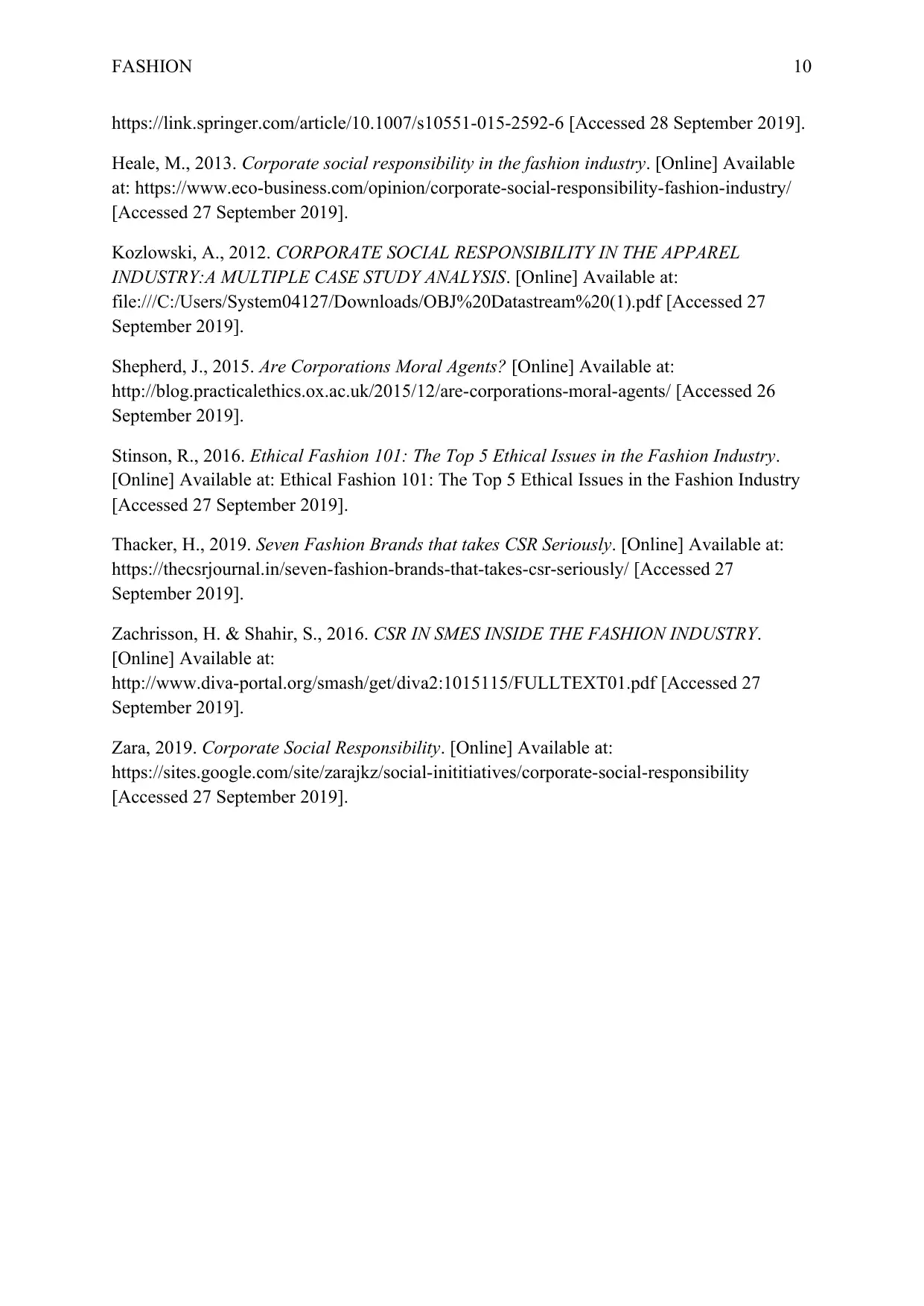
FASHION 10
https://link.springer.com/article/10.1007/s10551-015-2592-6 [Accessed 28 September 2019].
Heale, M., 2013. Corporate social responsibility in the fashion industry. [Online] Available
at: https://www.eco-business.com/opinion/corporate-social-responsibility-fashion-industry/
[Accessed 27 September 2019].
Kozlowski, A., 2012. CORPORATE SOCIAL RESPONSIBILITY IN THE APPAREL
INDUSTRY:A MULTIPLE CASE STUDY ANALYSIS. [Online] Available at:
file:///C:/Users/System04127/Downloads/OBJ%20Datastream%20(1).pdf [Accessed 27
September 2019].
Shepherd, J., 2015. Are Corporations Moral Agents? [Online] Available at:
http://blog.practicalethics.ox.ac.uk/2015/12/are-corporations-moral-agents/ [Accessed 26
September 2019].
Stinson, R., 2016. Ethical Fashion 101: The Top 5 Ethical Issues in the Fashion Industry.
[Online] Available at: Ethical Fashion 101: The Top 5 Ethical Issues in the Fashion Industry
[Accessed 27 September 2019].
Thacker, H., 2019. Seven Fashion Brands that takes CSR Seriously. [Online] Available at:
https://thecsrjournal.in/seven-fashion-brands-that-takes-csr-seriously/ [Accessed 27
September 2019].
Zachrisson, H. & Shahir, S., 2016. CSR IN SMES INSIDE THE FASHION INDUSTRY.
[Online] Available at:
http://www.diva-portal.org/smash/get/diva2:1015115/FULLTEXT01.pdf [Accessed 27
September 2019].
Zara, 2019. Corporate Social Responsibility. [Online] Available at:
https://sites.google.com/site/zarajkz/social-inititiatives/corporate-social-responsibility
[Accessed 27 September 2019].
https://link.springer.com/article/10.1007/s10551-015-2592-6 [Accessed 28 September 2019].
Heale, M., 2013. Corporate social responsibility in the fashion industry. [Online] Available
at: https://www.eco-business.com/opinion/corporate-social-responsibility-fashion-industry/
[Accessed 27 September 2019].
Kozlowski, A., 2012. CORPORATE SOCIAL RESPONSIBILITY IN THE APPAREL
INDUSTRY:A MULTIPLE CASE STUDY ANALYSIS. [Online] Available at:
file:///C:/Users/System04127/Downloads/OBJ%20Datastream%20(1).pdf [Accessed 27
September 2019].
Shepherd, J., 2015. Are Corporations Moral Agents? [Online] Available at:
http://blog.practicalethics.ox.ac.uk/2015/12/are-corporations-moral-agents/ [Accessed 26
September 2019].
Stinson, R., 2016. Ethical Fashion 101: The Top 5 Ethical Issues in the Fashion Industry.
[Online] Available at: Ethical Fashion 101: The Top 5 Ethical Issues in the Fashion Industry
[Accessed 27 September 2019].
Thacker, H., 2019. Seven Fashion Brands that takes CSR Seriously. [Online] Available at:
https://thecsrjournal.in/seven-fashion-brands-that-takes-csr-seriously/ [Accessed 27
September 2019].
Zachrisson, H. & Shahir, S., 2016. CSR IN SMES INSIDE THE FASHION INDUSTRY.
[Online] Available at:
http://www.diva-portal.org/smash/get/diva2:1015115/FULLTEXT01.pdf [Accessed 27
September 2019].
Zara, 2019. Corporate Social Responsibility. [Online] Available at:
https://sites.google.com/site/zarajkz/social-inititiatives/corporate-social-responsibility
[Accessed 27 September 2019].
1 out of 11
Related Documents
Your All-in-One AI-Powered Toolkit for Academic Success.
+13062052269
info@desklib.com
Available 24*7 on WhatsApp / Email
![[object Object]](/_next/static/media/star-bottom.7253800d.svg)
Unlock your academic potential
Copyright © 2020–2025 A2Z Services. All Rights Reserved. Developed and managed by ZUCOL.





